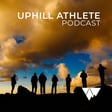Introduction to Aerobic Base
00:00:04
Speaker
Welcome to this episode of Uphill Athlete Podcast. I'm your host, Scott Johnston, co-founder of Uphill Athlete. And today, I'll be discussing the idea of aerobic bass. Let me preface this talk by saying that this is just a teaser. And if you want to really dig into this subject, you should read chapter two of our latest book, Training for the Uphill Athlete.
Importance of Aerobic Base
00:00:28
Speaker
This term aerobic base gets tossed around so casually you'd think it was part of the common lexicon of every athlete. In my experience, there's a paucity of information on this concept. In this talk, I plan to explain what it is, why it matters, how to tell when you don't have it, and how you can develop and maintain it. Before we launch into the meat of the subject, we need to all be on the same page in terms of physiology.
00:00:56
Speaker
It will greatly improve your grasp of the subject if you've even a basic understanding of how the muscles produce the energy needed to propel you. Don't worry, this will be just a very cursory explanation, no biochemistry needed.
Basics of Energy Metabolism
00:01:11
Speaker
Central to this whole discussion is a molecule known as ATP, adenosine triphosphate.
00:01:18
Speaker
ATP is referred to as the energy currency or the gasoline of your body's energetics. Every cell in your body, excluding the red blood cells, runs on the energy contained in the chemical bonds of the ATP molecule. The formation of ATP inside the cell is called, by a term most people are familiar with but may not fully understand, metabolism. Of particular interest to the athletes,
00:01:47
Speaker
is how ATP is formed in the muscles because ATP is the source of the energy that allows muscles to contract, which of course is what propels you. Our cells have two multi-step metabolic ways of making ATP.
Aerobic vs Anaerobic Pathways
00:02:03
Speaker
One of these metabolic processes involves oxygen and is called the aerobic or the oxidative metabolic pathway.
00:02:11
Speaker
The other is called anaerobic glycolysis or the anaerobic metabolic pathway because it involves no oxygen and can only break down glucose which comes from the carbohydrates you eat. With me so far? Good. That's about as far down the metabolism rabbit hole will need to go. So the next step
00:02:34
Speaker
Both metabolic pathways are used to provide ATP during almost all endurance level exercise, but the balance between how much of the required ATP is coming from which pathway is a function of two things. The first is the intensity. The higher the intensity, such as the faster you're moving,
00:02:56
Speaker
the more the anaerobic glycolytic pathway will be contributing because that pathway rapidly breaks down glucose so the rate of ATP production can keep up with that faster pace that you're running at. There are downsides to this rapid process though. One is that you can burn through your stores of glucose in a big hurry.
00:03:18
Speaker
Another is that this process can lead to the buildup in the muscle cells of what are called metabolites. Think of them as kind of a waste product. Those metabolites start to gum up the works and slow that metabolic pathway down. It's sort of a negative feedback loop because the more you need that glycolytic pathway, the less it's available once certain limits are reached.
00:03:44
Speaker
The next thing that establishes which metabolic pathway will be used is the train state of the athlete.
Benefits of Aerobic Metabolism
00:03:50
Speaker
If the athlete has a bigger aerobic base, then more of the ATP can be produced using the aerobic metabolic pathway, even at faster paces. So even though the aerobic pathway is slower to crank out ATP, meaning that it can't support very high intensity work, it has a few advantages over the anaerobic process.
00:04:12
Speaker
It does not result in the build-up of those nasty metabolites that slow things down, so it does not have that negative feedback loop built in. It also is a multi-fuel engine that can use fat or glucose, which comes from the carbohydrates, and even protein in extreme cases as the fuel to power the process of making ATP.
00:04:34
Speaker
And that's a good thing because your fat fuel tank is about 50 times larger than your glucose fuel tank that the carbohydrates fill up. The end result is that you can go much further if you're good at using fat as your fuel of choice. That's a very desirable thing in exercise, especially exercise that lasts several hours at a time.
00:04:55
Speaker
Finally, the aerobic metabolic pathway responds very well to training, so there's enormous potential to improve this for all but the most highly trained endurance athletes.
Reevaluating Lactate's Role
00:05:06
Speaker
Why does any of this matter?
00:05:09
Speaker
Even with this casual understanding of metabolism, you might already be seeing that increasing the aerobic metabolic pathway's ATP output while decreasing the contribution from the anaerobic pathway would have some significant benefits for the endurance athlete. A big aerobic base allows you to move faster for longer. Since that's exactly the goal for any endurance athlete, we should talk more about how this happens.
00:05:36
Speaker
Remember those waste products that accumulate in the muscle during high intensity work like fast running? Remember also how that buildup tends to slow down the very same anaerobic metabolism that is producing the ATP needed to support that fast running? Well, it turns out that one of the primary waste culprits, lactate, a molecule named lactate,
00:05:59
Speaker
is not really a waste product at all. In fact, it's a valuable fuel for the aerobic metabolic pathway. The slow twitch muscle fibers that rely mostly on aerobic metabolism can take up and use that lactate that is being created by the fast running and would otherwise accumulate and cause you to slow down.
00:06:18
Speaker
In fact, lactate is actually a preferred fuel for slow twitch fibers because it's a form of sugar that has already been partially broken down so it can more easily be metabolized by the muscle cell.
00:06:31
Speaker
It might be helpful to think of these aerobically well-endowed slow-twitch muscle fibers acting like vacuum cleaners, sucking up that excess lactate and making use of it as a fuel for cranking out more ATP. So it's really a win-win situation. The bigger the vacuum cleaner, the more lactate that can be taken up and used effectively instead of gumming up the works. This means you can run faster for longer without the debilitating effects of high levels of accumulated lactate.
Lactate Shuttle Theory
00:07:01
Speaker
In a very real sense, the vacuum cleaner is the aerobic base. The bigger the vacuum, the more endurance.
00:07:08
Speaker
But here's a brief historical aside. This is one of those cases I discussed in the evidence-based coaching podcast where coaches knew the importance of the big aerobic base and science came along decades later to explain what was happening. A prominent physiology researcher named George Brooks identified in 1984 this process whereby lactate is moved from where it is produced in the muscles to where it can be used as fuel to propel you up the mountain. Needless to say, he didn't call it a vacuum cleaner though. That's my name for it.
00:07:38
Speaker
He turned with a lactate shuttle. So in short, when an endurance athlete improves his or her aerobic base, that athlete will be able to move faster for longer with fewer ill effects. That's a very positive development and we want to now look at how to accomplish this goal.
00:08:00
Speaker
But before we do that, I want to take a minute to explain the role of high intensity training for the endurance athlete.
Impact of High-Intensity Training
00:08:06
Speaker
Training at higher intensities than the aerobic base levels, by that I mean levels where lactate is accumulating, should be an important part of any endurance athlete's overall training program.
00:08:18
Speaker
But you need to be aware that high intensity training primarily benefits the anaerobic metabolic pathway and only minimally affects the aerobic metabolic pathway. In fact, too much high intensity training can result in a decrease in one's aerobic base. We'll talk about how much is too much in just a moment.
00:08:39
Speaker
High and low intensity training result in completely different training effects. The common misconception is that high intensity training is a shortcut to endurance fitness and that low intensity is too easy to be effective. But actually the correct view is that each method has an important role to play in developing aerobic endurance.
00:08:59
Speaker
The all too common over-reliance on high intensity training is so prevalent in the popular fitness world that I'd guess that at least 80% of the new athletes we sign up for coaching have an underdeveloped aerobic base. So how do we recognize that underdeveloped aerobic base and what do we do to recommend to fix it? Well, first a couple of the terms to discuss.
00:09:24
Speaker
The terminology surrounding the concept of aerobic base can be rather vague. We prefer to define the aerobic base as it relates to a fairly well-understood metabolic breakpoint that's pretty easy to measure in each individual.
Defining Aerobic Threshold
00:09:38
Speaker
Unfortunately, thanks to a lack of consensus in sports science, this point, this metabolic breakpoint, has several names. We, and many others, refer to it as the aerobic threshold, but it's also referred to often as the first ventilatory threshold, written as VT1, which is the point where the rate and depth of breathing take a noticeable jump.
00:10:03
Speaker
but it can also be called the lactate threshold, the point where blood lactate concentration begins to rise above the lowest levels. To accurately measure VT1, you'd need some very expensive lab equipment, although a conversational pace or nose breathing can be used to kind of crudely locate that point.
00:10:24
Speaker
To find the lactate threshold, you'd need also a specialized tool called a lactate meter. Neither of these options is very satisfactory for most athletes. Because we're advocates for individualized training prescriptions, which necessitates knowing each athlete's physiological response to exercise, we want to find this metabolic reference point upon which we can base each individual's training. But we want the process to not involve a trip to the lab that can cost hundreds of dollars.
00:10:55
Speaker
We prefer a simple, self-administered field test for the determination of the aerobic threshold. Once you've identified your aerobic threshold, your aerobic base is no longer going to be defined in vague terms with some hand waving.
00:11:10
Speaker
After that, the next step is to determine a higher intensity metabolic event that is in a very real sense your endurance limit. In other words, the intensity you can maintain for an extended period. This simple test can range from 30 to 60 minutes. We call this the anaerobic threshold test. But as with the confusing terminology surrounding aerobic threshold, there is a remarkable lack of consensus defining this important point as well.
00:11:38
Speaker
But in both cases, we've adopted what seemed to be the most common usage. But it's important to not get hung up on the terminology. Semantics are not that important here.
00:11:49
Speaker
Once we have these two important points defined, we have quite a good understanding of the state of that athlete's aerobic system as it relates to endurance.
Elite Athletes' Thresholds
00:11:58
Speaker
So how can you know that you should believe what I'm telling you? Well, it's simple because thousands of coaches have noticed over decades while coaching millions of athletes that those who have the best endurance results have aerobic threshold heart rates that are more than 90% of their anaerobic threshold heart rate.
00:12:16
Speaker
so that the gap between the low-intensity aerobic threshold that defines a person's aerobic base and the endurance limit, the anaerobic threshold, should be 10% or less in terms of heart rate. Elite athletes can have a gap between these thresholds of as low as 5-7%.
00:12:37
Speaker
In our evidence-based coaching podcast, I mentioned that there is no scientific study that I know of that verifies this 10% phenomenon. It's only supported by empirical observations of real athletes by coaches.
00:12:53
Speaker
Because so many athletes come to us with this gap being 20 or even 30%, we've adopted a term to describe this condition, aerobic deficiency syndrome, or ADS. I want to give credit to the originator of this term, Dr. Phil Maffetone, who explained it to me in the early 1980s. This again is a term that you will not find in your search of the scientific literature.
00:13:18
Speaker
As I also mentioned in the evidence-based coaching podcast, there's no study verifying this phenomenon. So how can you know it's true? Because despite there being no study, there's an overwhelming amount of coaching anecdotal evidence to support both the 10% concept and the condition we describe as ADS. Before we move on to explain how to fix ADS, I want to give a real-world example of what a big aerobic base looks like.
00:13:50
Speaker
So the marathon, the road running marathon is a popular event all over the world. Anyone who watches a top flight marathoner can't help but be in awe of the elite performer's unimaginable pace. There's no better demonstration of how the aerobic base works. So consider this for just a moment. The marathon is an event that is competed at just slightly above one's aerobic threshold. That's right, the aerobic threshold.
00:14:20
Speaker
Let that sink in. The elite male running a 205 marathon is in the exact same metabolic state as the weekend warrior hoping to go under four hours. The elite runner is not running harder.
Sustaining Marathon Speed
00:14:33
Speaker
He's just running a lot faster at his aerobic threshold than the amateur runner is.
00:14:39
Speaker
In fact, an elite pace will be under 4 minutes and 50 seconds per mile or about 3 minutes per kilometer. Most of us, for the entire 26 miles, most of us would have a hard time running even one lap of the track at that pace.
00:14:57
Speaker
These highly trained athletes have a massive aerobic base, meaning that their aerobic threshold is very close to their anaerobic threshold. Their aerobic metabolic pathway is so well developed that they can sustain what would be a near full out sprint for most of us for over two hours. So how do they do that?
00:15:16
Speaker
Well, you might not have a lifelong running history nor the genetics of those elites, but you can still learn some really valuable lessons to apply to your own training from looking at the physiology and training practices of the best endurance athletes.
Polarized Training Approach
00:15:32
Speaker
So this is one place where there's a very interesting study that also supports the best coaching practice.
00:15:39
Speaker
This is a metadata study that was conducted by Steven Seiler in the early 2000s. In that study, Seiler looked at a training regimen of top endurance athletes to try to figure out if there was some commonality between different endurance sports. In that study, he found that the elites of all these different sports tended to spend about 90% of their annual training hours training below their anaerobic threshold.
00:16:06
Speaker
and only about 10% training above it. Of that 90% below the anaerobic threshold, the vast majority, also something like 90% of that, was done at or under the lower aerobic threshold. So that means that about 80% of these elite athletes training was done at or below their aerobic threshold.
00:16:28
Speaker
Very important to keep that idea in mind. In a subsequent study, linked to in the notes below, he found that these exact same principles will also work for recreational runners. He's termed this method polarized training. But again, this is a system of training that has been in use for many decades before Seiler pointed it out in the scientific literature.
00:16:52
Speaker
So from the above, you can see that it's best to think of high intensity training as a supplement to not a replacement for low intensity training.
00:17:03
Speaker
Many of the athletes come to us suffering from ADS have been engaged in some sort of high intensity exercise regime several days a week. This can range from something organized like spin classes, CrossFit, P90X, Boot Camp, or it might be that they have only 30 minutes to run before they have to pick up their kids from soccer so they run as hard as they can for as long as they have time.
00:17:26
Speaker
This is an understandable and intuitive approach to training. If you're mostly training right at your endurance limit, surely that endurance limits might improve, right? Well, in the short term, as measured in a few weeks, that is true. But in the long term, it will backfire and actually decrease the endurance limit because the vacuum cleaner is getting smaller. Others show up to us with no prior training history.
00:17:53
Speaker
Since both these cases are very likely to be candidates for ADS, we start right off with the tests mentioned above. The good news for those with ADS is that there is a big performance gain to be made just by improving that aerobic base.
00:18:10
Speaker
even without adding high intensity training until the ADS is cured. I have seen even high level athletes improve their pace at aerobic threshold for 10 straight years. We routinely get comments from both athletes we coach and people who email us after adopting our methods who tell us of improvements of 10 to 20% in pace at aerobic threshold within six months.
Addressing Aerobic Deficiency Syndrome
00:18:36
Speaker
Below I've linked to an in-depth article on this site. It'll be in the notes below, the show notes below.
00:18:45
Speaker
For those suffering the effects of ADS, like barely being able to run without a heart rate that skyrockets, or needing to walk on the slightest uphill, or else they're gasping for breath, the recipe for training is really quite simple. The main focus, if you hope to have long-term success in endurance activities, is to raise that aerobic threshold, both in terms of pace and heart rate.
00:19:08
Speaker
Until you correct aerobic deficiency syndrome, any hopes of performing at your best in long durations, say over about one hour, endurance events of any kind will be in vain. For these folks, the training prescription is accumulate as much training volume as you can handle from both the time constraint and the energy management side. That sounds simple, right? It is kind of, but there is some bad news here.
00:19:39
Speaker
The single biggest factor for improving the aerobic base or aerobic threshold is the volume or duration of training. That's the reason top marathoners run 100 plus miles a week and most top endurance athletes train 800 plus hours a year. There's no shortcut to improved endurance despite what the fitness magazines keep pushing. If there was, don't you think the professionals would be using it? So training volume is the key to fixing ADS.
00:20:07
Speaker
What do you do when you can't devote that many hours that are needed to accomplish this? Well, you need to first of all have realistic expectations. Your goals need to be in line with your ability to commit. You first have to come to grips with the fact that human physiology does not care that you're working 60 hours per week.
00:20:26
Speaker
There is no secret biohack despite the constant barrage of get fit quick schemes promoted by the fitness industry and popular media. That's what I mean by tempering expectations. You can still train for and make big improvements, but chances are good that you will not be the next Killian Jornet if you're 40 years old, have a demanding job and a family.
00:20:49
Speaker
Each of us, even the professionals, has limits when it comes to the time and energy we can devote to training. But this is especially true for the amateur. Jumping into a professional or elite level training program in hopes of fixing ADS is not advisable. That is an almost surefire route to injury or over-training.
00:21:10
Speaker
So while volume is key, each athlete is going to have to balance their desire to cure the ADS and the limitations with their limitations in time and energy. One very easy way to tell if you're doing your aerobic base training within your energy limits is this simple test.
00:21:29
Speaker
Can you do today the same workout you did yesterday and then do it again tomorrow and the day after and the day after? If so, you know you're recovering well enough that you might consider bumping the volume of this low intensity work up slightly if time permits. If, on the other hand, you're not fully recovering in 24 hours, there's a good chance that the combination of training stress and life stress is too great and you need to cut back someplace.
00:21:58
Speaker
It will take longer to move the aerobic threshold needle with a smaller volume of base training, but it will move.
Maintaining Aerobic Base
00:22:06
Speaker
If you're doing five to six hours of aerobic base training in a week, it might take six or eight months to induce the same change that you'd see in six to eight weeks if you were training 10 to 12 hours per week.
00:22:19
Speaker
When it comes to maintaining the base that you've built up with the many hours of work, there's some good news. It takes significantly less work to maintain a level of aerobic fitness than it did to create that level in the first place. After an extended base training period of six to eight months and curing ADS, a maintenance program of roughly 50% of the previous peak volumes will allow your aerobic base to be maintained for many weeks at a stretch.
00:22:51
Speaker
Well, that wraps up this overview of the aerobic base concept.
Conclusion and Resources
00:22:54
Speaker
I hope it has shed some light on this often overlooked and misunderstood area of your endurance training. We look forward to seeing you in our next uphill athlete podcast. Thanks for joining us today. For more information about what we do, please go to our website, uphillathlete.com.




















